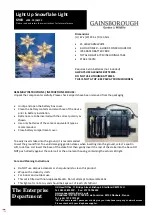
Chapter 2: Prerequisites
Product Service 1-800-522-7658
4
The first option for venting the pressure relief valve is for ducting unfiltered
air to the outside via a 4" nominal diameter exhaust duct. The second and
third options for venting the pressure relief valve will add HEPA filters
and/or carbon filters to the exhaust duct and allow the vented air back into the
laboratory or to the outside. The HEPA filtered and carbon filtered pressure
relief vent kits may be combined if so desired. All pressure relief valve vent
kits include a 4" diameter thimble duct connection to aid in the connection to
the building exhaust blower preventing the pressure relief valve from
activating due to the negative pressure of the building exhaust. Labconco
offers accessory remote blowers listed in Chapter 7 for your convenience in
venting the pressure relief to the outside. These blowers have a 6" diameter
nominal inlet and a 4" x 6" duct transition is necessary to adapt from the 4"
diameter thimble connection provided with all relief valve kits.
WARNING: In the case of failure caused by excessive
vacuum within the main chamber, the user must safely
determine whether laboratory atmosphere entering the
glove box could result in fire, explosive hazard or damage
to property inside the glove box.
See Figures 3-1, 3-2, and 3-3 in Chapter 3 for ventilation connection
diagrams of the vent kits.
Electrical Requirements
Electrical receptacles should be located nearby for connecting the glove box,
or other optional laboratory equipment. The entire glove box is rated 115V,
8A or 230V, 4A or 100V, 8A. One duplex outlet is located inside the glove
box and is rated for 115V, 5A or 230V, 2A or 100V, 5A. Additional power
strip accessories are available and can be connected to the interior duplex
outlet (see Chapter 7).
Plumbing Requirements for Gas, Vacuum, and
Drying Train
The Precise Controlled Atmosphere Glove Box has four valves located on the
main glove box chamber and two valves located on the transfer chamber.
Two of the four valves on the main chamber should be used for the operation
of the main chamber gas inlet and vacuum outlet lines. To prevent
overpressurization, the gas inlet lines should be set at a pressure of 10-30 psi
through the use of a gas supply pressure regulator. The other two valves on
the main chamber can be used for connections to a recirculating drying train.
Drying trains are recirculating contaminate removal traps, powered by
vacuum pumps. They are used for the removal of oxygen and/or moisture
from the main chamber atmosphere. They can also be used to remove
organic vapors, acids, ammonia, or radioisotopes. See Chapter 7 for ordering
!









































